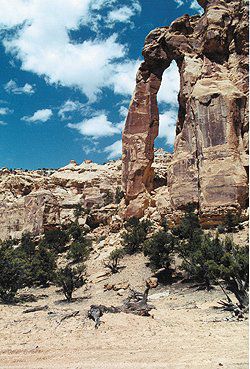For the first time, the protection of millions of acres of Utah’s public lands managed by the Bureau of Land Management will be considered by the U.S. House Subcommittee on National Parks, Forests and Public Lands on Oct 1. Rep. Raul Grijalva (D-AZ) and Maurice Hinchey (D-NY), the long-time sponsor of America’s Red Rock Wilderness Act, announced the hearing.
“This is a historic moment in the long effort to protect Utah’s magnificent wilderness landscapes throughout the state,” said Scott Groene. “Places like Cedar Mesa, the San Rafael Swell, the Green River and the West Desert are one step closer to achieving the lasting protection they need and deserve. Some of Utah’s most spectacular places will be protected from off-road vehicle damage, water pollution, and oil wells; hunters, anglers and families will have opportunities to experience the overwhelming quiet and awe that these landscapes offer. All Americans will be able to visit these special places and know that they will be met with the same peace and beauty that previous generations have enjoyed.”
America’s Red Rock Wilderness Act was first introduced in Congress in 1989 by Wayne Owens (D. Utah), who recognized that the serpentine canyons, plateaus and wild country of southern Utah was worthy of wilderness protection. These lands had long been threatened by oil and gas drilling, uranium and other mineral mining, roads, and off-road vehicle use. When Rep. Owens left Congress in 1992, he asked his close friend Rep. Hinchey to sponsor the bill who currently enjoys the support of 137 cosponsors in the House. In 1998, Senator Richard Durbin (D-IL) introduced America’s Red Rock Wilderness Act in the Senate and remains its sponsor today, along with 20 co-sponsors in the 111th Congress.
America’s Red Rock Wilderness Act would designate about 9 million acres of BLM lands in Utah as Wilderness, including the Book Cliffs, Vermilion Cliffs, San Rafael Reef and the Wah Wah Mountains.
Grazing, hiking, backpacking, scientific study, photography, guiding and other non-motorized and non-mechanized activity are all allowed in Wilderness.
Even after passage of the Red Rock bill, there will still be tens of thousands of miles of primitive dirt roads and trails crossing public lands available for motorized use, including routes which provide access to the Wilderness lands.
The vast majority of BLM would still be available for oil and gas development on BLM lands in Utah after passage of the Red Rock bill. Additionally, at the end of FY 2008, 5 million acres of BLM lands were under lease in Utah, with only 1.5 million acres of those lands in production.
The benefits of Wilderness designation include buffering the land from the effects of climate change, protection of critical water resources, providing a haven for archaeological sites long threatened by widespread looting, and protecting large blocks of habitat for native plant and animal life like bear, cougar, bald eagle and other species, including those pressured by drought and habitat stress brought about by climate change.
The BLM, in ongoing inventories, has recognized that 7.1 million acres, 74 percent of the bill, qualify for wilderness protection, validating the acres in the Red Rock bill in nearly every instance. Most of the remaining acres in the bill have yet to be properly inventoried by BLM.
The outdoor industry contributes more than $6 billion annually to Utah’s economy and depends on the preservation of Utah’s public lands to continue growing its customer base in Utah and around the country.
“The tide is decisively turning away from the Bush administration’s ‘drill anywhere” approach to public lands. It’s a new day for Utah wilderness, one that will be marked by respect for one of this nation’s most treasured landscapes, while carefully locating development and roads only where the land can sustain that kind of use. It’s a fitting first step to mark the end of Wilderness Month,” said Myke Bybee, Sierra Club’s public lands and wilderness representative.
“There’s a growing recognition across the country, including in Utah, that designating wilderness can be good for communities now and into the future,” said Julie Mack, Utah State Director for The Wilderness Society. “We look forward to working with Utahns to ensure that these scenic treasures are protected.”
“Oil and gas interests have tried and tried again to get their hands on Utah’s most valuable pristine lands,” said Sharon Buccino, Director the Lands and Wildlife Program at the Natural Resources Defense Council. “We believe wilderness is central to our nation’s natural heritage. Future generations deserve to enjoy it as we have. NRDC is hardly alone in this belief, which is why this hearing is an important step forward in protecting these unique lands.”
“We applaud Congress for taking steps forward on the Red Rock bill by holding this hearing,” noted Jessica Ennis, Legislative Associate for Earthjustice. “This is especially timely given the increased scrutiny over the Bush administration’s six controversial resource management plans and the opportunities before the Obama administration to protect these lands.”
America’s Red Rock Wilderness Act was developed through the efforts of hundreds of citizen volunteers who have hiked and mapped every one of the proposal’s 285 units. It is supported by the Utah Wilderness Coalition, including the Southern Utah Wilderness Alliance, The Sierra Club, Earthjustice, Natural Resources Defense Council, The Wilderness Society, and more than 200 member organizations of the Utah Wilderness Coalition, representing millions of Utahns and Americans alike.
America’s Red Rock Wilderness first hearing

"Forty-five percent of Emery County is being considered for wilderness."
